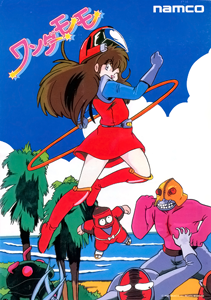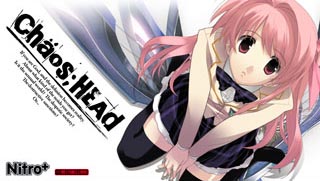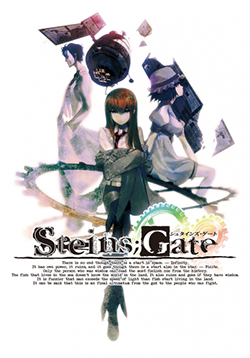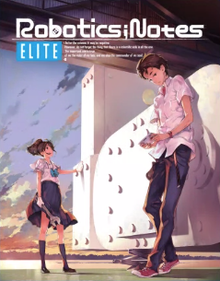
Wonder Momo is a 1987 beat 'em up arcade game that was developed and published by Namco exclusively in Japan. It was ported to the PC-Engine in 1989, with both versions of the game later ported to the Wii Virtual Console, and ported to Nintendo Switch and PlayStation 4 as part of Arcade Archives. The game was also included in Namco Museum Encore for the PlayStation. Wonder Momo inspired a webcomic series in 2012, an anime miniseries in 2014, and a sequel game by WayForward Technologies in May 2014. A sequel titled Wonder Momo 2 was planned for the arcades on 1993, but was cancelled due to decline of popularity.

Chaos;Head is a 2008 science fiction visual novel video game developed by 5pb. and Nitroplus. It is the first game in the Science Adventure series. Following the original Windows release, the enhanced version Chaos;Head Noah was released for Xbox 360 in 2009, and has since been ported to multiple platforms. An English localization was released by Spike Chunsoft for Nintendo Switch and Windows in 2022. The game follows Takumi Nishijou, who gets involved in the "New Gen" serial murder case. He frequently experiences delusions and hallucinations, some of which the player can influence, which affects the progression of the story.

Memories Off 6: T-wave is a Japanese romance visual novel developed by 5pb. originally released for the PlayStation 2 console on August 21, 2008. It was released for the Xbox 360 on August 27, 2009. This was the second game in the Memories Off series to be developed by 5pb. after exclusive development and distribution rights of the series was transferred over to 5pb. from Cyberfront. A manga adaptation of the game was published in the Comic Alive magazine in 2008.

Steins;Gate is a 2009 science fiction visual novel game developed by 5pb. and Nitroplus. It is the second game in the Science Adventure series, following Chaos;Head. The story follows a group of students as they discover and develop technology that gives them the means to change the past. The gameplay in Steins;Gate includes branching scenarios with courses of interaction.
Mages Inc., formerly 5pb. Inc., is a Japanese video game developer and record label for video game and anime music. It was formed on April 6, 2005, after Chiyomaru Shikura left Scitron to begin the company as its executive director, a position he formerly held until January 2023. The company is divided into two parts, 5pb. Games for the manufacturing of video games, and 5pb. Records for the record label. It was a wholly owned subsidiary of the TYO Group until Shikura purchased the remaining rights from the TYO Group on April 15, 2009. Shikura co-owns 5pb. with AGOne, an affiliate of Dwango Japan. Staff members include scenario writer Naotaka Hayashi, artist Yukihiro Matsuo, and producer Tatsuya Matsuhara.

Chaos;Head Love Chu Chu! is a romantic comedy visual novel video game developed by 5pb. and Nitroplus. It is part of the Science Adventure series, and is the direct sequel of the 2009 game Chaos;Head NoAH. It was released for Xbox 360 on March 25, 2010, and later released for PlayStation Portable, PlayStation 3 and PlayStation Vita.

Asami Imai is a Japanese voice actress and singer affiliated with Early Wing. She debuted as a voice actress in 1999 and as singer in 2009 by releasing her first single "Day by Day / Shining Blue Rain" under the 5pb. Records label. She is also well known for giving voices to Chihaya Kisaragi in THE IDOLM@STER, Kurisu Makise in Steins;Gate, Tsubaki Yayoi in BlazBlue, and Ayumi Shinozaki in Corpse Party. She along with Eri Kitamura formed the music unit Artery Vein which is also under the 5pb. label.

Phi Brain: Puzzle of God is a 2011 Japanese anime television series produced by Sunrise. The first two series aired on NHK Educational TV between October 2011 and September 2012, with a third season airing as of October 2013. The series is directed by Junichi Sato with script supervision by Mayori Sekijima. Hajime Yatate, the collective pen name for the creative staff at Sunrise, is credited with the original story. The anime has been licensed in North America by Sentai Filmworks. A manga adaptation by Yoshiki Togawa was serialized in Kadokawa Shoten's Newtype Ace magazine from November 2011 to December 2011. A PlayStation Portable video game by Arc System Works was released on May 31, 2012.

Sora Tokui is a Japanese voice actress, singer, and manga artist who made her debut as a voice actress in 2009 as Himemiya in Weiß Survive R.

Science Adventure is a multimedia series consisting of interconnected science fiction stories, created mainly by Mages, Nitroplus, and Chiyomaru Studio. The main entries mostly take the form of visual novel video games, but side entries span across several different mediums.
Ayano Yamamoto is a Japanese actress, voice actress and idol. She is affiliated with the agency Amuleto. She is known for her involvement in Nitroplus' franchise Super Sonico.

Occultic;Nine is a Japanese light novel series written by Chiyomaru Shikura, and is a part of the Science Adventure franchise. It was later adapted into a visual novel and published by Mages in November 2017. The light novel series is licensed in English by J-Novel Club. A manga, illustrated by Ganjii, was serialized in Kodansha's good! Afternoon from October 2015 to May 2017. An anime television series adaptation by A-1 Pictures aired between October and December 2016.

Chaos;Child is a visual novel video game developed by 5pb. It is the fourth main entry in the Science Adventure series, and a thematic sequel to Chaos;Head (2008). It was released in Japan in 2014 for Xbox One, and later for PlayStation 3, PlayStation 4, PlayStation Vita, Microsoft Windows, iOS, Android, and Nintendo Switch. An English localization was released for the PlayStation 4 and PlayStation Vita by PQube in 2017, and for Windows by Spike Chunsoft in 2019.

Steins;Gate: Linear Bounded Phenogram is a visual novel video game developed and published by 5pb. for PlayStation 3, Xbox 360, and PlayStation Vita in 2013, and later ported to iOS, Nintendo Switch, PlayStation 4, and Microsoft Windows; the PlayStation 4 and Windows versions were released internationally by Spike Chunsoft in 2019. The game is part of the Science Adventure series, and a spin-off from the 2009 game Steins;Gate. It consists of ten side stories set in different realities, and follow different Steins;Gate characters. Unlike previous entries in the Steins;Gate series, the game is nearly devoid of interactive narrative.

Steins;Gate: My Darling's Embrace is a visual novel video game developed by 5pb., originally released for the Xbox 360 in 2011. It has since been ported to several other platforms, and was released by Spike Chunsoft in English for the Nintendo Switch, PlayStation 4, and Microsoft Windows in 2019. It is part of the Science Adventure series, and a spin-off from the 2009 game Steins;Gate. The game is a romantic comedy set in a different world from the one in the original Steins;Gate, where the player builds romantic relationships with Steins;Gate characters. By making certain choices and interacting with the player character's cell phone, the player can affect the direction of the plot.

Chaos;Child is a 2017 anime series based on the visual novel of the same name created by Mages and Nitroplus, and is part of the Science Adventure franchise. It was directed by Masato Jinbo at Silver Link, with music by Takeshi Abo and Onoken, and with main cast members from the video game reprising their roles.

Steins;Gate Elite is a science fiction visual novel and interactive movie video game, part of the Science Adventure series. It was developed by 5pb. for PlayStation 4, PlayStation Vita, Nintendo Switch, Microsoft Windows and iOS, and was released in September 2018 in Japan and in February 2019 internationally. It is an updated, fully animated remake of the 2009 game Steins;Gate, using footage from the anime adaptation of the original game along with newly produced animation by White Fox.

Robotics;Notes DaSH, is a visual novel video game developed by Mages. It is part of the Science Adventure series, and is a sequel to the 2012 game Robotics;Notes. It was released in 2019 in Japan for the PlayStation 4 and Nintendo Switch, and was released in English in 2020 for the same platforms and Windows by Spike Chunsoft. The game was written by Toru Yasumoto and Chiyomaru Shikura and produced by Tatsuya Matsubara, with character designs by Tomonori Fukuda, mechanical designs by Makoto Ishiwata and Yukihiro Matsuo, and music by Takeshi Abo.

My Girlfriend Is Shobitch is a Japanese manga written and illustrated by Namiru Matsumoto. It was serialized online on Niconico Seiga from July 2015 to September 2019. An anime television series adaptation by Diomedéa and Studio Blanc aired from October to December 2017.

















